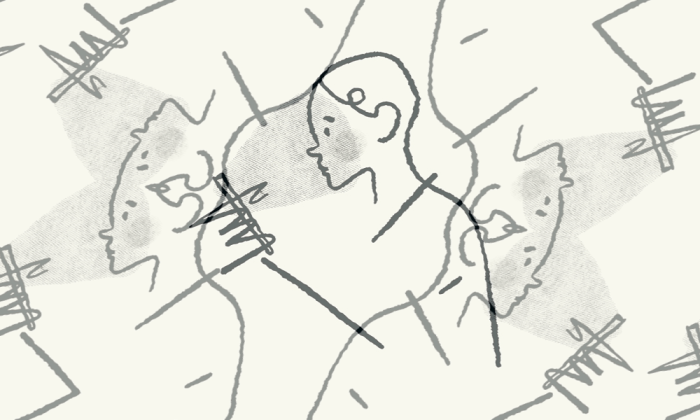A Brief History of Disengagement, From Couch Potatoes to Users

In 1976, as the story goes, Tom Iacino was on a phone call with another member of a Southern California humor group that favored watching television instead of pursuing a healthy lifestyle. He condensed the phrase “boob tube” and “tuber” into a tidy pun, giving birth to the phrase “couch potato.” Another member of the group, Robert Armstrong, teamed up with a writer to pen the slim, pocketable “Official Couch Potato Handbook” (1983), which unreservedly embraces the stereotype of excessive television watching. It offers tongue-in-cheek anthems to television, television cuisine (toaster ovens figure prominently), advanced lessons on “simulviewing” multiple TV channels at the same time, and a prehistory that connects television with Moses’s fire, Plato’s cave, and William Blake. What sets a couch potato apart from a casual viewer, the book claims, is his prolonged viewing sessions, which can make viewers “vegetal.” To paint television as a device for turning viewers into vegetable-like objects is a running theme in “The Official Couch Potato Handbook”: At one point, the authors discuss watching sports until the viewer passes out; at another, they joke that it’s hard to tell if a couch potato is dead or just glued to the tube. The handbook portrays its ideal viewer as devoid of agency — they have been “programmed,” in a good way, by TV — and more object than subject.

These jokes about couch potatoes capture the zeitgeist of a country in the throes of economic stagnation but are ultimately about the laziness of white people: A reader of the handbook quickly notices that there’s only a single fleeting image of a person of color in the whole book, from a cartoon about unemployed couch potatoes in Detroit. In contrast, in the public discourse of the time, fear-mongering politicians invoked the supposed laziness of Black subjects — a long-standing trope of racism in the American context — as they railed against people taking advantage of the welfare system. So-called welfare “reform” efforts, invoking the rhetoric of restoring agency and “personal responsibility,” ultimately dismantled the welfare system. Whom we call a couch potato and whom we deride for taking advantage of the welfare system has less to do with actual consumption practices than with who has the privilege to be lazy. While the couch potato was comically vegetal, the figure of a welfare recipient whiling away the hours watching television instead of working took on grimmer, almost-dead qualities: She seemed devitalized as a subject, only partially alive. It’s an impression that reflects a widespread understanding of television as breeding an extreme degree of passivity. Yet television’s passivity has always been overrated; plenty of other mediums involve sitting on the couch and being sedentary, such as reading a book or being an audiophile.
Algorithms prod us to engage and to be active in order to create ourselves as users.
Both the “couch potato” and the image of someone lazily enjoying their welfare benefits seem somewhat quaint today. We appear to have made a break from the medium of television itself and the viewership it engenders. In cultural critic Laurence Scott’s words, we are in a “post-potato age”; even a user binging on a TV series online is likely to simultaneously check notifications on a phone or search the actor’s bio in another window. A user has become defined as a multitasker. Even the political question around television-watching welfare recipients seems to have retreated into the background, having served its purpose now that the U.S. welfare system has been dismantled. Contemporary life is typically portrayed as an age of perpetual anxiety and frantic attention, of multitasking and nonstop notifications. As media scholar Lisa Parks puts it, “whereas television viewers are perceived as passive couch potatoes, computer users are by comparison seen as active and overworked.” Algorithms prod us to engage and to be active in order to create ourselves as users.
Yet experts continue to warn us that interactivity can quickly become just another form of screen addiction. Apps for killing time are, in one critic’s phrase, the digital equivalents of high-fructose corn syrup; they are giving us “cultural diabetes.” Technology magazines describe today’s look of oversaturated colors that pop on a smartphone display — aesthetic decisions encoded into filters and computational photography, and then normalized as simply how photographs now look — as “eye candy.” Critics compare screen addictions to binge eating: “In today’s world, technology may be more like food than it is like alcohol,” writes one. “[Consumers] must rebuild their relationship with food while continuing to eat every day.” Public health scholars and journalists seek out guidance from the U.S. Food and Drug Administration and the World Health Organization for “screen addiction,” reasoning that the screen is like sugar and that sites like TikTok and Instagram prey on our cravings for it.
Perhaps the main difference between the couch potato and the user is simply that it is almost impossible to opt out of the work of being a user. Users now interact even when they want to space out — that is, they now actively space out — meaning that the division between activity and passivity has become even more tenuous than before.
The algorithms that track user activity turn doing nothing into a sort of interaction that is captured as data: Netflix, for example, reads a failure to click on a suggestion as a lack of interest in it — a signal that informs their algorithms for future suggestions. Algorithms can now infer users even in the absence of tracking cookies or explicit user accounts, for example, by using probabilistic measures to calculate the uniqueness of a user’s browser identifier and IP address across websites. And the recent surge in platforms designed to monetize lurking, idleness, and casual viewership, such as Twitch, the video-game streaming site that Amazon bought for $1 billion in 2014, are a sign that so-called passive users are simply the next marketplace for digital capitalism’s expansion; a user’s interests can be easily inferred by examining whom they watch or follow. Passivity is just another way to interact with the systems of digital capitalism.
The recent surge in platforms designed to monetize lurking, idleness, and casual viewership are a sign that so-called passive users are simply the next marketplace for digital capitalism’s expansion.
The only people who seem to be less affected by this new reality are the well-off. Researchers found that children in more affluent families log on an average of 90 minutes a day less than low-income families; the phenomenon of Silicon Valley venture capitalists and executives who have banned or severely limited screen time for their children is so widespread that the New York Times has called it a “consensus.” Yet their employers and ventures promote screen time as a cheap substitute for public investment. In an underfunded school district near Wichita, Kansas, the Facebook-funded nonprofit Summit Learning attempted to “disrupt” education by distributing Chromebooks and implementing a web-based learning program that largely did away with interpersonal interactions. The result of this experiment, as remote learners and workers quickly discovered during the COVID-19 pandemic, has been headaches, eye strain, stress, anxiety, “kids that all look like zombies,” and even multiple seizures a day from one student suffering from epilepsy. To be off-screen is, in contrast, a relative privilege of those who can afford personal tutors, time off, or anonymity.
One group that embodies the seeming excesses of screen addiction is the Internet addict who doesn’t want to work; today’s equivalent of the couch potato, they are in government parlance referred to as NEETs (neither employed nor in education or training) or the “disconnected” youth. Political economist Nicholas Eberstadt estimates that there are roughly eight million male members of the American labor force who stubbornly refuse to enter the labor force. In contrast to unemployed men who still hope for a job, he writes, “‘socializing, relaxing and leisure’ is a full-time occupation, accounting for 3,000 hours a year, much of this time in front of television or computer screens . . . Time-use surveys suggest that [NEETs] are almost entirely idle — helping out around the house less than unemployed men; caring for others less than employed women; volunteering and engaging in religious activities less than working men and women or unemployed men.” For Eberstadt, these screen-based activities seem to evince a bad domesticity, in which NEETs are too lazy to even “care for others,” let alone enter the public sphere: “the death of work seems to mean also the death of civic engagement, community participation and voluntary association.”
Disconnected from the economy, the NEETs serve as a particularly galling irritant to political commentators on both the right and the left. To neoliberals on the right, represented by Eberstadt, this is because their on-screen activities seem to be neither work nor free time. Free time is traditionally defined by the workday or work week, that is, as a way to unwind before the next day at the office or factory, or, alternately, as time off from the routines of housework. Consequently, watching TV, as those imagined to be exploiting welfare benefits supposedly did, or playing video games simply to pass the time, unmoored from any connection to work (waged or domestic), devalues the system of productivity on which both work and free time are predicated. This is why Eberstadt invokes the moral gravity of vagrancy: “Among those [men] who should be most capable of shouldering the burdens of civic responsibilities it instead encourages sloth, idleness, and vices perhaps more insidious.” To the left, NEETs seem antisocial or anti-communitarian, rather than prosocial, giving even left-leaning thinkers pause before championing their forms of idleness.
That the debate about screens is really about a debate over sociality is already anticipated by “The Official Couch Potato Handbook.” In one telling moment, the book briefly notes the existence of video games and newer, two-way television systems, but argues against interactive technologies: “Why watch television if you have to think and respond? If you are going to have to respond you might as well . . . cultivate friendships or read a book or something.” Its advice on intimacy is similarly asocial: sex is “not recommended” as it would interfere with television viewing; in any case, “sex is overrated anyway.” And it describes television as a way of reducing crime: “When people are watching TV, they don’t have time for antisocial activity,” presumably because television makes them disengaged with society at large, advice that is unusually appropriate for today’s networked age, where the new form of work involves “cultivating friendships” and “responding.” Now, the new figure of unfitness is not so much the couch potato as the user who is reticent, disconnected, or disinterested.
But the asociality represented by watching TV or wasting time on screens may be ways of coping with these pressures of connecting and being social. In his book “Politics after Television,” media scholar Arvind Rajagopal describes an Indian mechanic’s family that understands television as a form of “timepass,” or wasting time. For them, watching television dampens the usual squabbles and flare-ups of domestic conflicts, and it offers a brief window of privacy inside an otherwise crowded home.
In a digital age, timepass offers a chance to temporarily forget the continual pressure for a user to connect and network with others, waiting decoupled from proper sociality. It offers an attenuated, lower-commitment version of having to converse, connect, or interact with others, not to mention to continually account for oneself. In its digital context, timepass represents a set of forms, genres, and ways of coping that, in digital media scholar James Hodge’s words, allow you to “be yourself without having to show up too much.” Another example of Hodge’s, who studies new aesthetic forms of digital media, is the way users capture a small dose of emotion in the reaction GIF. The briefness of these forms has given rise to the phrase “the feels,” a small and often uncertain dose of feeling (“five feels equals one-third of a human emotion,” calculated Katy Waldman in Slate in 2015), a formulation that speaks to the ways of diminishing without disconnecting completely. Timepass is particularly needed for those for whom sociality can feel mandatory, rather than voluntary — rideshare drivers who feel forced to be social with their passengers. Rather than walling oneself away, the asocial subject continues to imagine relation, however deferred or postponed — a missed connection that is nevertheless felt as a connection.
The so-called crisis of asociality is an iteration of the same problem of gender and racial economic inequality that has been with us all along.
Conditions of asociality, it turns out, are disproportionately, even overwhelmingly, felt not by the white male NEETs that Eberstadt describes but by people of color: In America, according to 2020 report by the Social Science Research Council, a Native American person aged 16 to 24 is 2.5 times as likely, a Black person 1.9 times as likely, and a Latinx person 40 percent more likely to be as “disconnected” from society as a white person of the same age group. This suggests that the so-called crisis of asociality is an iteration of the same problem of gender and racial economic inequality that has been with us all along. Socialization is itself often a tool for excluding people.
Timepass allows us to give form to space in between the moments of interaction demanded of us, the moments when time is simply passed rather than being directed toward a purpose. If the typical impulse is to frame such time as a matter of moral concern, then we might reclaim timepass as a way of describing the intervals “in the meantime.” Shilpa Phadke, a coauthor on a book on the right of women to loiter in Mumbai, has described her own online life in similar terms. Not utopian, she writes, but sometimes it’s what’s possible given the circumstances outside:
I wonder if I have the energy or enthusiasm to actually change my clothes and head out for that walk, safe or not. Often, I choose to loiter online instead. . . . Sometime I might have multiple chat windows open with friends loitering with me. I might also stop at a pornographic site or a sex chat site and wander in there … As I loiter, I could well be sipping a cup of adrak chai (ginger tea) or a glass of wine.
That wandering is a combination of interest and disinterest, excitement and slack, leaving and staying: not the recipe for a revolution, but a way for us to while away time before we have to be ourselves again.
Tung-Hui Hu is Associate Professor of English at the University of Michigan. A former network engineer and a published poet, he is the author of “A Prehistory of the Cloud” and “Digital Lethargy,” from which this article is adapted. He was awarded the Rome Prize in Literature in 2022.



